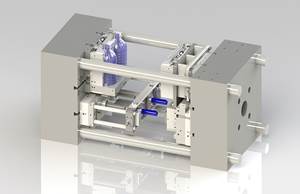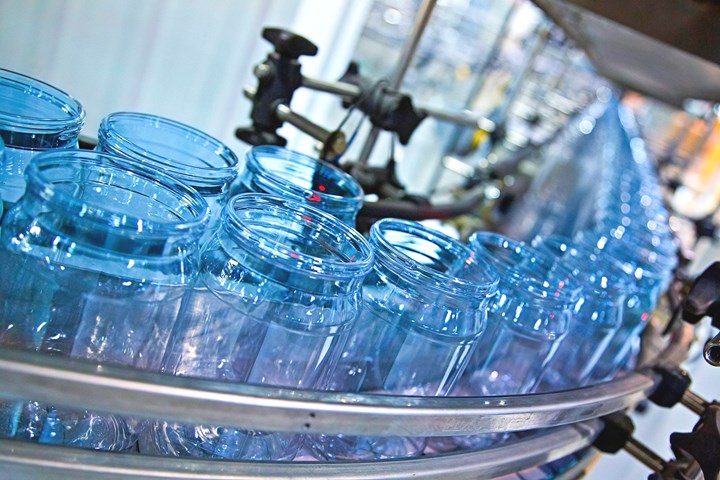
Ring Container has developed a growing stable of proprietary technologies emphasizing source reduction, recyclability and performance enhancements in barrier and hot-filling. Trimlite PET jars, shown here, use blow-trim technology to lightweight the neck area.
Ring Container Technologies is not your average blow molder. For one thing, it’s bigger: Based in Oakland, Tenn., the firm (ringcontainer.com) operates 20 plants in 14 states, Canada and the U.K. It employs around 850 and plans to reach $600 million in sales this year. It’s also distinctive in its commitment to advancing technology in container blow molding.
“We don’t want to be a me-too. Our foundation is being entrepreneurial.”
“We consider ourselves a technology company,” says Paul Kelley, v.p. of product development. “We are committed to research; we have a tremendous product development group. We keep abreast of innovations in the market. We seek to identify what our customers will need in the near future and what their customers will need—and we will be working on it well in advance.”
While other molders may aim to compete by taking advantage of the latest machine and materials technology on the market, Ring Container is focused on innovation. “We don’t want to be a me-too,” says Kelley. “Our foundation is being entrepreneurial.” Over the years, that entrepreneurial drive has produced half a dozen trademarked innovations that set benchmarks in lightweighting, hot filling, recyclability and proprietary barrier technology.

The company’s foundational product is the Ultra 35 HDPE edible-oil jug in a corrugated box. Overall, it weighs 30% less than the competition, and Ring is working to cut more weight and add more recycle.
A Half-Century of Innovation
The company history goes back more than 50 years to the late 1960s, when Ring Container was named for the family that founded it. Today it’s still privately owned by MSD Capital of N.Y.C.
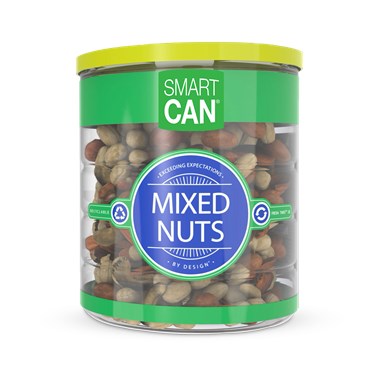
An offshoot of Trimlite is the all-PET SmartCAN, a 35% lighter and fully recyclable alternative to composite cans. Its first commercial use was in 2020.
Ring’s main markets today are food packaging—accounting for over 70% of its volume—along with pet care and agricultural chemicals. Its production is about evenly split between extrusion blow molded HDPE and injection stretch-blow molded PET. HDPE molding on around 50 reciprocating-screw and wheel machines is devoted mostly to the company’s original product, 35-lb jugs for edible oils. In the last 10 to 15 years, Ring Container expanded into PET, specializing in wide-mouth containers molded on one-station and two-station machines. This is now the higher-growth portion of the company’s business. Ring has 60 machines for stretch-blow molding and injection molding PET preforms. The company is also looking into the emerging field of extrusion-blown PET, or EPET.
“Dependability is a differentiator in our market. Customers trust us for predictable delivery and consistent quality.”
“We have grown every year in upper single digits,” says president and COO Brian Smith. “Our revenue decreased in 2020, due to the pandemic, but our bottom line still improved.”
“What we bring to the market is innovation, quality and service,” explains Kelley. “Dependability is a differentiator in our market. Customers trust us—for predictable delivery (something that’s easy to do in easy times, unlike these times), consistent quality, and ability to flex production schedules and machine platforms.”
Smith notes that the company was built on “focused plant” philosophy: “Each plant has an anchor customer for that location. Most plants are focused on a particular material—either HDPE or PET.”
As Kelley noted above, Ring Container has become focused on innovation. Its product-development staff of 15 scientists, process engineers and design engineers has grown 30-40% in the past four to five years. Forty percent of that staff is stationed at the Tennessee headquarters, and the rest at other locations. Their resources include CAD for 3D modeling and structural simulation, as well as several 3D printers to make prototype container models and prototype blow molds. Ring is investing millions of dollars for a state-of-the-art sampling lab to be completed this year. What’s more, innovation involves cross-functional teams that include development staff and members from sales and operations, as well as outside resources—for example, to contribute insights from consumer research.
Sustainability Drives Innovation
According to Tim Ferrel, v.p. of business development, “Our industry today is focused on sustainability,” but Ring Container was out in front of this issue before some others. “We invested a lot in R&D on sustainability, for things our customers didn’t even yet know they wanted or needed.”
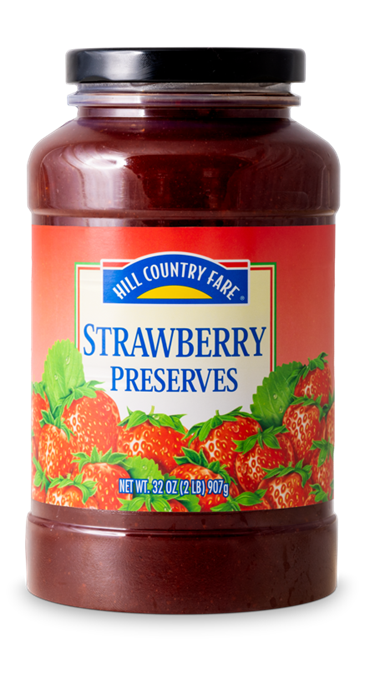
HotLock extends Trimlite technology into hot-fill PET (up to 195 F). First applications are in jams and jellies.
This emphasis goes all the way back to the company’s foundational product, the Ultra 35 HDPE edible-oil jug packaged in a corrugated box. Ring’s version of this industry-standard 35-lb package weighs 30% less overall than the competition, due to lightweighting of both the plastic and corrugated portions. “We’re working to drive out another 10% of weight,” says Ferrel.
Among more recent developments, he cites the example of Trimlite, a patented technology for wide-mouth PET containers (70 to 120 mm) that was commercialized in the mid-2000s. It allows weight reduction of up to 40% in jars for dressings, sauces, oils, spreads, snack foods, dairy products, pet food and more. Blowing a dome above the neck finish that is subsequently trimmed off makes a lighter container than one with an injection molded neck.
A case in point is a 48-oz mayonnaise jar: Compared with typical competition, it weighs 16% less but achieves 31.7% higher crystallinity, 10.9% greater topload strength, 47.4% higher vacuum resistance, and 45.5% improved seal burst strength.
This blow-trim technology was also the foundation of SmartCAN, an all-PET can for snack foods and other dry products. It is a fully recyclable alternative to common composite cans, and is 35% lighter overall than a composite alternative. The first commercial application was announced in early 2020 and is currently made by two-stage ISBM.
HotLock, launched in 2020, is extension of Trimlite technology to hot-fill markets. Because it weighs 85% less than glass jars, this heat-set PET alternative is said to offer significant savings in energy use and greenhouse gas emissions for transportation and handling. Compared with other hot-fillable PET jars, HotLock is distinguished by larger neck sizes, use of metal lug caps, and higher filling temperatures—up to 195 F, according to Kelley. Ring Container launched this product line initially for jams and jellies but is now looking at other pasteurized foods.
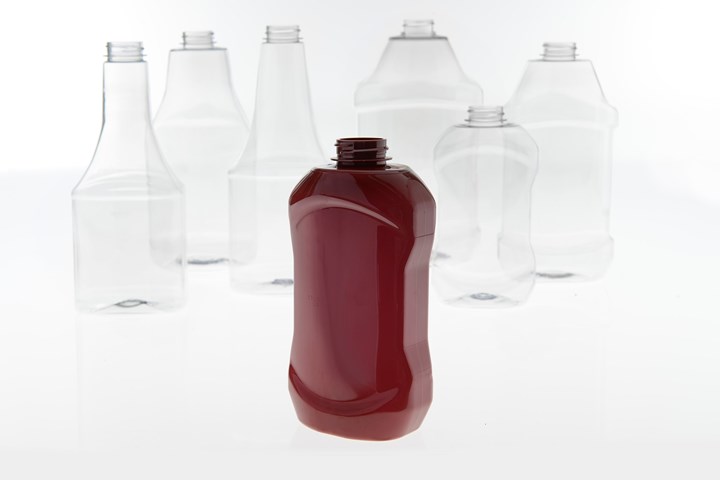
A promising new development is Barrier Guard OxygenSmart, with a proprietary oxygen-barrier additive that allows PET ketchup bottles to achieve the first “Widely Recycled” label.
The year 2021 saw introduction of two more proprietary technologies, both for barrier PET containers. BarrierGuard OxygenSmart is a patent-pending, 100% recyclable container that can accept more than 50% rPET with no effect on barrier protection. It is described by the company as “the first oxygen-additive barrier bottle technology that allows ketchup bottles to be designated as Widely Recycled” by How2Recycle, a U.S. nonprofit organization dedicated to uniform labeling of recyclability.
Although the technology is closely guarded while the patent is pending, Kelley told Plastics Technology, “It is a concentrated barrier that contains a polyester copolymer.”
Ring Container boasts “the first oxygen-additive barrier bottle technology that allows ketchup bottles to be designated as Widely Recycled.”
Besides glass-like clarity, this technology reportedly outperforms other barrier systems, both multilayer and monolayer. BarrierGuard OxygenSmart is said to provide up to 24 months’ protection against oxygen, moisture and aroma loss. What’s more, the company states that “our process ensures the barrier is not initiated until the product is put inside the container, so empty bottles in inventory do not need expiry dates.”
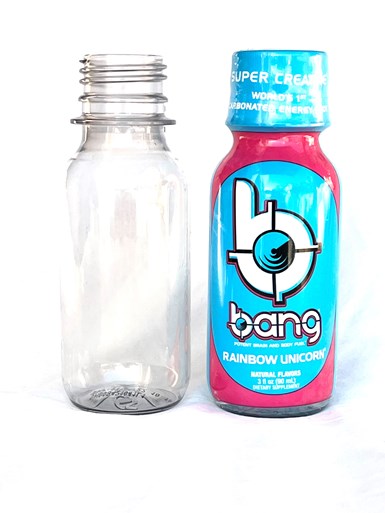
Also new in the past year is BarrierGuard Enhance, a multilayer PET/nylon barrier technology for small energy shots, seltzers and other carbonated beverages.
The other brand-new barrier PET technology is BarrierGuard Enhance, a solution to the difficult challenge of retaining carbonation in very small bottles—2 to 3 oz—for energy shots, seltzers and other carbonated beverages. The technology involves two-stage ISBM production of containers with a thin barrier layer of nylon, which Kelley says is also protective for oxygen-sensitive products. Not only can these bottles integrate use of post-consumer recycled (PCR) materials, but Kelley reports that the maker of the barrier resin, Mitsubishi Chemical, and Husky Injection Molding Systems, which builds preform injection systems, have had success in demonstrating recyclability of these small PET bottles, which contain only a tiny amount of nylon.
As evidenced by these examples, Ring Container is pursuing sustainability on several tracks: source reduction (lightweighting), enhanced recyclability and recycle content. The firm is even looking into renewable biopolymers.
While use of rPET by Ring’s customers is “just getting started,” according to Kelley, the firm is using up to 20-25% rHDPE in products such as pet care. Recycle content is not currently used in the Ultra 35 oil jugs—except in the corrugated box—but Kelley anticipates that changing in the future.
Overall, Kelley feels that recycling is still in its early stages in food packaging. “A few customers have already launched products with PCR, and a lot are talking about it happening in the next couple of years.” Limiting factors continue to be availability and cost.
Although it doesn’t affect its container business, Ring has a sister company that claims to be the largest recycler of polystyrene in the U.S. Founded in 1984, it’s called RAPAC and is located alongside Ring in Oakland, Tenn. RAPAC reprocesses 40 million lb/yr of EPS into its own line of EcoSix PS and EPS products.
Related Content
At NPE, Cypet to Show Latest Achievements in Large PET Containers
Maker of one-stage ISBM machines will show off new sizes and styles of handled and stackable PET containers, including novel interlocking products.
Read MoreRecyclability of PET/PEF Multilayer Barrier Bottles Gets Further Validation
Europe’s RecyClass considers PET/PEF multilayer bottles to be fully recyclable in the PET stream.
Read MoreLight-Blocking Additive for PET Dairy Packaging
Avient’s Lactra LX additive enables blocking of 100% visible light in monolayer PET.
Read MoreCircular Plastics From Cyclic Molecules
Macrocycle is pioneering an approach to PET recycling via cyclic oligomers.
Read MoreRead Next
Beyond Prototypes: 8 Ways the Plastics Industry Is Using 3D Printing
Plastics processors are finding applications for 3D printing around the plant and across the supply chain. Here are 8 examples to look for at NPE2024.
Read MoreFor PLASTICS' CEO Seaholm, NPE to Shine Light on Sustainability Successes
With advocacy, communication and sustainability as three main pillars, Seaholm leads a trade association to NPE that ‘is more active today than we have ever been.’
Read More














